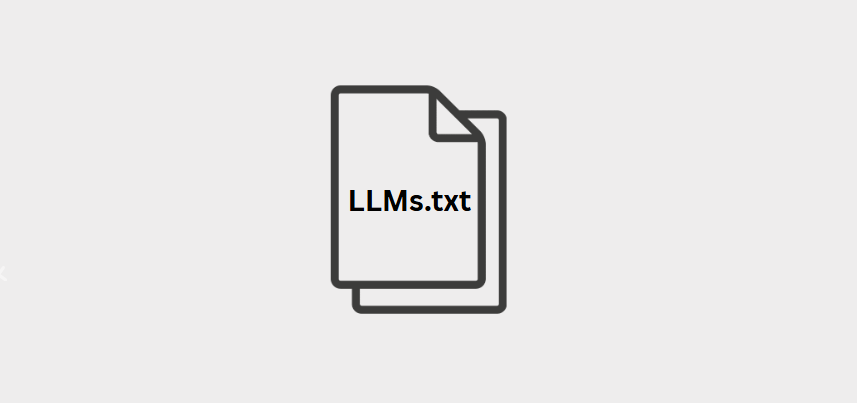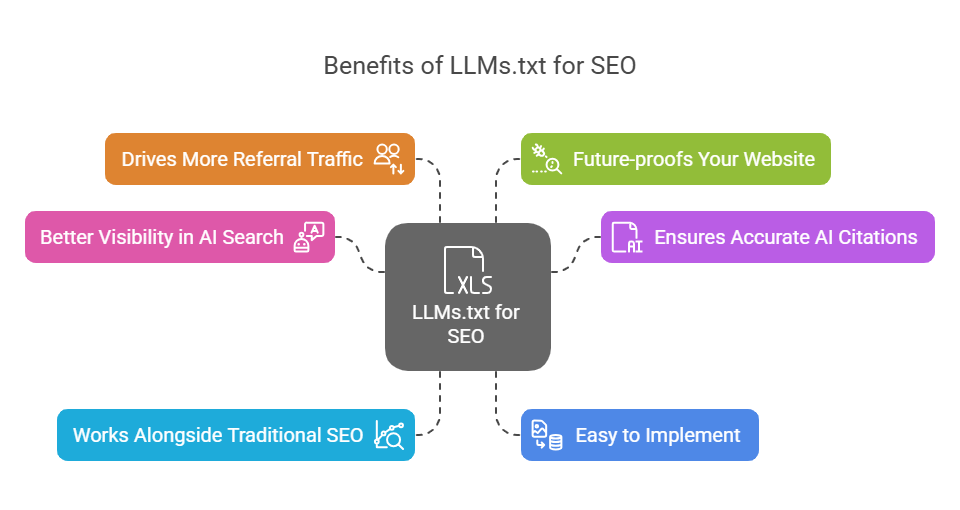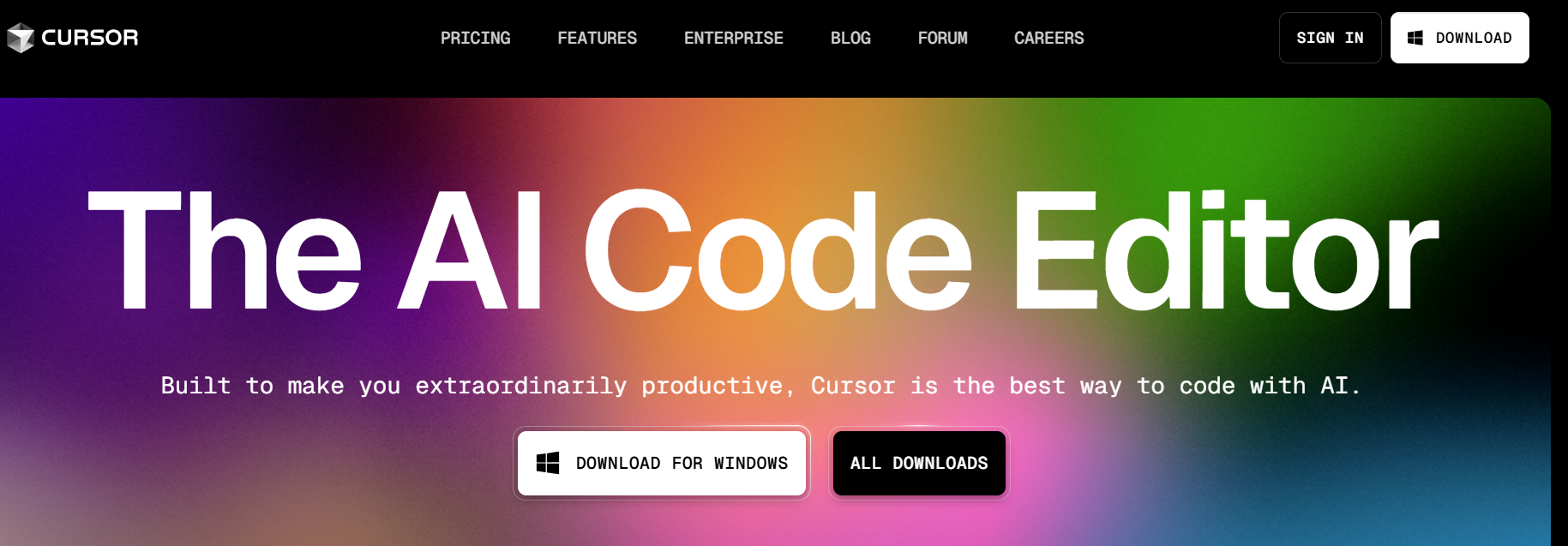SEO is shifting fast, and a quiet change is gaining traction: the llms.txt file. This simple text file sits on your website and helps AI systems—like chatbots and search tools—understand what your content is about.
Think of it as a guide written for machines. While traditional websites are built with humans in mind, llms.txt gives AI a cleaner, clearer version of your most important pages. It helps models pick up context faster, reduce confusion, and get the right information in front of the right people.
What is LLMs.txt?

LLMs.txt is a new proposed web standard designed to help large language models (LLMs)—like ChatGPT, Claude, or Gemini—understand your website better.
Think of it like a custom guidebook for AI. While robots.txt controls what bots can crawl and sitemap.xml lists your pages, LLMs.txt tells AI which pages actually matter, and why. It’s a human-readable and AI-friendly Markdown file that lives at the root of your website.
For SaaS companies and content-heavy websites, implementing LLMs.txt can improve AI visibility, drive better citations, and improve user engagement.
Let’s explore how LLMs.txt works and why it’s becoming an important part of modern SEO strategies, particularly with the rise of AI technologies .
Why LLM matters for SEO
As AI-powered search engines become more important. LLMs.txt is turning into a key tool for helping websites work better with large language models (LLMs). Here’s why llms.txt files matter for SEO strategies:

- Better visibility in AI search: Guides AI models to prioritize your key content, increasing the chances of being referenced in AI-generated responses.
- Ensures accurate AI citations: Helps control what AI says about your business by highlighting the relevant information on your site.
- Works alongside traditional SEO: Complements robots.txt and sitemaps by directing AI models to your most valuable pages.
- Easy to implement: It’s just a simple Markdown file you upload to your site.
- Drives more referral traffic: Boosts AI citations, leading to more organic visits from AI-generated answers.
- Future-proofs your website: Prepares your site for the rise of AI-powered search, giving you a competitive edge.
How large language models (LLMS) work
LLMs.txt gives AI a simplified, structured version of your most important content. It highlights your top pages and provides short descriptions for each. Here’s a simplified breakdown of how large language models work:

- Trained on massive data sets: LLMs process textual data from books, websites, and other sources to learn language patterns.
- Use deep learning & neural networks: They rely on generative pre trained transformer models (like GPT and Claude) to predict and generate text based on context, requiring a deep understanding of programming languages.
- Understand context & meaning: By analyzing sentence structures, relationships between words, and user prompts, LLMs generate relevant responses.
- Limitations & token vocabulary constraints: LLMs have a fixed memory (token limit), meaning they can’t process unlimited data in one go and prioritize the most relevant information. The parameter count also affects model performance.
- Continuously improve with human feedback: Models refine their outputs through reinforcement learning, user interactions, and training data.
- Generate content, summarize, and analyze: LLMs can generate human like text and create articles, answer questions, translate text imitating human language, and extract key insights from complex tasks. This content creation is changing many business processes.
Understanding how LLMs work helps you optimize content for AI-driven search, improving visibility and ensuring AI extracts the right context from your site.
How to optimize your content for AI readability
Google, ChatGPT, and AI search engines extract, summarize, and display web content based on structure, clarity, and format. If you’re still not appearing in AI results, then you need to optimize your website for AI readability using the tips mentioned below:
- Clear headings & structure: Use clear headings like H1, H2, H3, and include bullet points to organize content to make it easy for AI to read and understand.
- AI-readable tables: For comparisons, use structured tables making it easier for AI to interpret and extract information from your content.
- FAQ sections & schema markup: Include FAQ sections and use schema markup to increase the chances of your content being featured in search results.
- Simple, direct language: Use simple and direct language over complex jargon to improve AI’s ability to comprehend and rank your content effectively.
- Internal linking: Internal linking helps AI understand the relationships between different pieces of content on your site, which can enhance its ability to rank your pages accurately.
- Optimized metadata: Optimize your titles and descriptions in your metadata to significantly influence how AI algorithms rank and display your content in search results.
What’s inside an LLMs.txt file
Here’s what a basic structure looks like:
How to create your own LLMs.txt file
Setting up an LLMs.txt file is simple, but doing it right ensures AI models recognize and prioritize your most important content . Follow these steps to create and implement your own LLMs.txt file:
1. Define your objective
Decide which content you want AI models to focus on. Examples:
- A SaaS platform may highlight onboarding guides and product documentation
- A blog-focused site might spotlight cornerstone articles and explainers
- An e-commerce brand could feature key product categories or buyer’s guides
2. Map your content
Categorize content into sections, such as “Product Information,” “Case Studies,” or “Help Docs.” Structure it in a way that makes it easy for AI models to process.
Make a list of high-value URLs. Skip pages like /login, /cart, /privacy-policy.
Example for a SaaS company:
- /docs/start
- /docs/api
- /tutorials/integrate-slack
- /pricing
- /case-studies/team-growth
Example for a content-heavy blog:
- /blog/how-to-use-ai-in-content-marketing
- /blog/seo-for-ai-search
- /resources/checklists/content-brief-template
3. Write it in Markdown
Use a simple Markdown-style format. Include links, short descriptions, and keywords for clarity. Structure the file like this:
| # Project Name
> Short summary of your company or purpose. ## Section name |
Use multiple sections (like Docs, Blog, Examples) to keep it organized. Include only the most useful links in each.
4. Save and upload
- Save it as llms.txt
- Upload it to the root directory of your site (e.g., https://yourwebsite.com/llms.txt)
- You can also create a longer version, llms-full.txt, which includes full documentation content (optional)
How to add LLMs.txt file to WordPress
Adding an LLMs.txt file to WordPress is straightforward, especially with the help of plugins. Here’s how you can do it:
- Install an LLMs.txt plugin
- Download a plugin such as “LLMs.txt for WP” or “Website LLMs.txt” from the WordPress plugin repository or GitHub.
- Navigate to your WordPress dashboard and go to Plugins > Add New > Upload Plugin.
- Upload the plugin ZIP file, then activate it.
- Configure the plugin settings
- After activation, go to Settings > LLMs.txt Settings in your WordPress admin panel.
- Select the pages, posts, or custom post types you want to include in the LLMs.txt file. You can also set limits on the number of posts or pages to include.
- Generate and access the file
- The plugin will automatically generate the LLMs.txt file and place it in your site’s root directory (e.g., https://yourwebsite.com/llms.txt).
- Visit this URL to confirm that the file is correctly formatted and accessible by AI crawlers15.
- Optional: enable markdown support
By using these plugins, you can easily manage and update your LLMs.txt file without any coding knowledge.
How to add LLMs.txt file to Webflow
To add an /llms.txt file to your Webflow website, you’ll need to upload the file to Webflow’s asset manager, then create a 301 redirect from the /llms.txt URL to the uploaded file’s URL.Here’s a step-by-step guide:
1. Create and upload the /llms.txt file:
- Create a text file named /llms.txt containing the information you want to provide to LLMs.
- Go to the Webflow designer, open the “Assets” panel, and upload your /llms.txt file.
2. Get the asset URL:
- Find the uploaded /llms.txt file in the Assets panel.
- Right-click on the file and select “Open in browser” to get the URL of the uploaded file.
3. Create a 301 redirect:
- Go to Project Settings in the Webflow designer, click on “Project Settings”.
- Go to the“Hosting” tab.
- Click on “Add Redirect” and create a new 301 redirect.
- Set the redirect from: Enter /llms.txt.
- To: Paste the URL of the uploaded /llms.txt file (obtained in step 2).
- Type: Choose “301 Permanent Redirect”.
- Save the redirect settings.
4. Publish your website:
- Publish your Webflow website to make the changes live.
Alternative Approach (using a Text Link):
- Create a text link: Add a text link to your page with any text, for example, “llms.txt”.
- Attach the file: Attach your /llms.txt file to the text link.
- Copy the link address: Copy the URL of the text link.
- Create a 301 Redirect: Follow the same steps as above to create a 301 redirect, but this time redirect from /llms.txt to the address of the text link.
Important Notes:
- Root directory access: Webflow users don’t have direct access to the root directory, so this method uses redirects to simulate it.
- File upload: Ensure the file is uploaded to the Webflow assets and not just linked to.
- Testing: After implementing, test that the /llms.txt file is accessible at the correct URL.
To clarify the file’s purpose, add:
| X-Robots-Tag: llms-txt |
6. Test it
- Open https://yourwebsite.com/llms.txt to check formatting
- Copy the contents into ChatGPT or Claude and ask, “What does this company do?”
- See how accurately AI understands your business
By creating an LLMs.txt file, you’re making it easier for AI models to understand and prioritize your content, improving visibility in AI-generated search results.
Creating an LLMs.txt file manually is simple, but using the right tools can speed up the process and ensure accuracy, ultimately enhancing model performance . Here are some useful tools to help you generate and manage your LLMs.txt file:

- Firecrawl Generator: AI-powered tool that helps structure and format LLMs.txt automatically. It scrapes your site to suggest the most relevant pages for AI indexing and builds a proper file.
- Dotenv llmstxt: Ideal for developers looking to integrate LLMs.txt management into their workflows. It helps automate content updates based on changes in your CMS. It can generates llms.txt from sitemap.xml.
- Mintlify: Best for documentation-heavy websites, ensuring AI models can access structured knowledge bases. It auto-generates llms.txt from your existing documentation.
- WordPress Plugin: If your site runs on WordPress, some SEO plugins now offer LLMs.txt integration. It lets you manage AI-specific indexing directly from your admin panel.
- Custom scripts & automation: If you prefer a customized approach, you can create scripts to dynamically update LLMs.txt. This is beneficial for large SaaS platforms where content changes frequently.Using these tools, you can efficiently create, update, and optimize your LLMs.txt file, helping AI models understand and prioritize your content for better visibility.
Best practices
To make the most of your LLMs.txt file, follow these best practices to ensure AI models can easily process and prioritize your content.

- Start with the essentials: Only include pages that provide real value to users or showcase your expertise. Skip outdated, low-quality, or irrelevant content.
- Use clear, concise descriptions: Keep descriptions short and to the point like 1–2 sentences max. Avoid jargon unless it’s widely understood in your industry.
- Organize with H2 sections: Structure your LLMs.txt file by content type (e.g., Docs, Blog, Case Studies, Features). This makes it easier for AI models to navigate and categorize your content.
- Keep it updated: Review and update your domain specific LLMs files at least once a quarter. Refresh it after major content updates, new product launches, or site changes.
- Use the “Optional” section wisely: Place secondary content like changelogs, terms of service, or community pages in an “Optional” section. This helps AI models prioritize core content while still referencing less critical pages when needed.
Following these best practices ensures that your LLMs.txt file stays clean, useful, and AI-friendly, improving your chances of being correctly cited in AI-generated responses.
How AI models use LLMs.txt
Currently, AI models don’t automatically detect LLMs.txt files, meaning you need to manually introduce them to Artificial Intelligence tools. Here’s how you can use them effectively:
With ChatGPT or Claude:

- Paste the LLMs.txt content or upload the file directly into the chat.
- Ask targeted questions like: “What are AcmeCorp’s main services?” to guide AI responses based on your curated content.
With Cursor:

- Add the file to your AI workspace via the @Docs feature.
- AI will then reference it when generating responses, keeping your content in context.
As LLMs adoption grows, AI tools may start automatically parsing LLMs.txt when available, making it a crucial part of future AI-driven search and content discovery.
Real-world examples
Many companies are already using LLMs.txt to improve how AI models interact with their content. Here are some real-world examples:
- Anthropic: Uses LLMs.txt to help AI models understand its API and prompt library, ensuring accurate AI-generated responses.
- Perplexity: Maintains a comprehensive llms-full.txt file for deep indexing of its help center, making its content more accessible to AI tools.
- Cloudflare: Leverages LLMs.txt to direct AI toward thousands of developer documentation pages, improving discoverability.
- Mintlify: Automates LLMs.txt creation for all the documentation it hosts, ensuring AI models always reference the latest information.
These examples show how LLMs.txt is already playing a key role in AI-first content optimization, helping businesses improve AI visibility and ensure accurate information retrieval.
Conclusion
LLMs.txt is a small yet impactful file that can significantly enhance your website’s performance in the AI-driven search platforms. By implementing LLMs.txt, you can improve visibility in AI chat tools and AI-powered search engines, ensuring your content reaches a wider audience.
Additionally, it provides AI systems with the context they need, moving beyond guesswork to deliver more accurate and relevant results. Perhaps most importantly, LLMs.txt helps future-proof your site in a world where AI tools are becoming the new standard for search, ensuring you stay competitive and visible.
The best part? Setting up LLMs.txt takes less than an hour, making it a quick and effective way to upgrade your SEO strategy for the AI age.
FAQS
What are foundation models, and why are they important for LLMs?
Foundation models are large-scale machine learning systems trained on vast datasets, enabling tasks across various domains. They power large language models (LLMs) and adapt to applications like text generation, code creation, and data analysis, making them crucial for generative AI and advanced business solutions.
How does fine-tuning improve the performance of large language models?
Fine-tuning allows businesses to customize LLMs for specific tasks by adjusting pre-trained models with domain-specific data. For example, a SaaS company can fine-tune an LLM to enhance customer support or optimize code generation workflows. This process ensures that the model delivers more accurate and relevant outputs tailored to unique business needs.
What is generative AI, and how does it relate to SEO?
Generative AI creates text, images, or code based on prompts. In SEO, generative AI can produce high-quality content optimized for search engines or assist in creating tools like LLMs.txt files that improve visibility in AI-powered search results.
How does artificial intelligence impact modern SEO strategies?
AI-powered tools are reshaping SEO by prioritizing structured data, accurate citations, and user-centric content. Tools like LLMs.txt work alongside AI systems to ensure websites are accurately represented in search results, driving more organic traffic and improving citation accuracy in AI-generated responses.
How do large language models generate text?
LLMs generate text by analyzing context from input data and predicting the next word or phrase in a sequence using transformer architecture. This enables them to produce coherent and contextually relevant responses for tasks like article writing, summarization, translation, or answering questions.
What business applications can benefit from using LLMs.txt?
Businesses can use LLMs.txt to improve content visibility, enhance citations in AI-generated answers, and future-proof their websites. SaaS companies can particularly benefit by highlighting onboarding guides or product documentation through this file.
Can large language models assist with code generation?
Yes, LLMs are highly effective for code generation tasks. They analyze programming patterns from extensive datasets and generate functional code snippets based on user prompts. This capability makes LLMs valuable for developers and SaaS companies looking to automate coding processes or build efficient software solutions.





